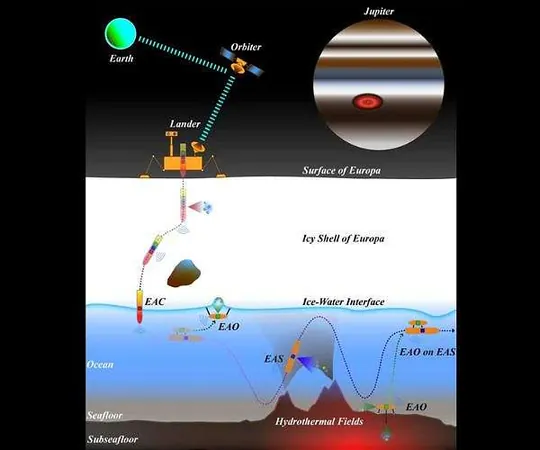
Unveiling Life Beyond Earth: How Autonomous Underwater Vehicles Could Change the Game on Icy Moons!
2025-01-05
Author: Yu
Exploring Icy Moons
In a groundbreaking approach to astrobiology, scientists are deploying Autonomous Underwater Vehicles (AUVs) known as Exo-AUVs to explore the icy worlds of our solar system, like Europa and Enceladus, which are believed to harbor the conditions necessary for extraterrestrial life.
With their intriguing icy shells and subsurface oceans, these moons provide a unique backdrop for searching for biosignatures—indicators of past or present life.
Focusing on Specific Zones
Recent research emphasizes the importance of focusing on specific zones within these icy terrains. The mission is clear: avoid simplistic, binary determinations about life and instead focus on the rich complexity of environments that might support biological processes.
By aligning missions with ecological theories observed on Earth, scientists can prioritize high-potential areas such as the ice-water interface and the ocean floor.
Multi-Phase Exploration Strategy
The proposed multi-phase strategy for these explorations involves four critical steps: assuming biological activity exists, sampling the environment, analyzing the collected data, and verifying findings.
Exo-AUVs, equipped with state-of-the-art technology, are adept at identifying micro-zones teeming with potential biological activity. They can gather a diverse array of biosignatures, giving scientists robust data for further study.
Challenges of Exploration
But exploring these distant worlds is no easy feat. Europa, with its thick layer of ice and vast underwater oceans, presents significant technological challenges.
Enter the innovative Multi-Exo-AUV System (MEAS), designed to operate in these extreme conditions. It includes ice-penetrating carriers that rely on advanced power systems like Small Modular Reactors (SMRs) or Radioisotope Thermal Generators (RTGs), enabling them to traverse the icy landscape while deploying specialized Exo-AUVs.
Technological Advances
These marvels of engineering are not just potent tools; they represent a paradigm shift in how we approach the hunt for extraterrestrial life.
Equipped with varied payloads that enable detailed acoustic, spectroscopic, molecular, and electrochemical analyses, the Exo-AUVs can detect and characterize biosignatures at scales ranging from kilometers down to micrometers.
Operational Autonomy
However, the vast distance from Earth introduces logistical hurdles, including communication delays of nearly half an hour.
To counter this, the Exo-AUVs have been designed with a high degree of autonomy, allowing them to localize, navigate, and carry out scientific analyses without real-time commands from Earth.
This independence is essential for ensuring successful missions over Europa's sprawling and inhospitable landscapes.
Future Roadmap
The visionary roadmap for the future of Exo-AUV technology involves addressing current limitations while enhancing operational autonomy and scalability for future exploratory missions.
It also promises a more comprehensive detection network, enabling scientists to explore Europa's global ice and ocean systems in unprecedented detail.
The Quest for Extraterrestrial Life
As humanity stands on the brink of potentially discovering extraterrestrial life, the sophisticated capabilities of Exo-AUVs remind us that we are not so far removed from asking and answering one of the most fundamental questions: Are we alone in the universe?
With every new experiment and mission, we draw closer to finding answers hidden beneath the ice of our solar system’s distant moons. Buckle up; the quest for alien life is just heating up!

 Brasil (PT)
Brasil (PT)
 Canada (EN)
Canada (EN)
 Chile (ES)
Chile (ES)
 Česko (CS)
Česko (CS)
 대한민국 (KO)
대한민국 (KO)
 España (ES)
España (ES)
 France (FR)
France (FR)
 Hong Kong (EN)
Hong Kong (EN)
 Italia (IT)
Italia (IT)
 日本 (JA)
日本 (JA)
 Magyarország (HU)
Magyarország (HU)
 Norge (NO)
Norge (NO)
 Polska (PL)
Polska (PL)
 Schweiz (DE)
Schweiz (DE)
 Singapore (EN)
Singapore (EN)
 Sverige (SV)
Sverige (SV)
 Suomi (FI)
Suomi (FI)
 Türkiye (TR)
Türkiye (TR)
 الإمارات العربية المتحدة (AR)
الإمارات العربية المتحدة (AR)